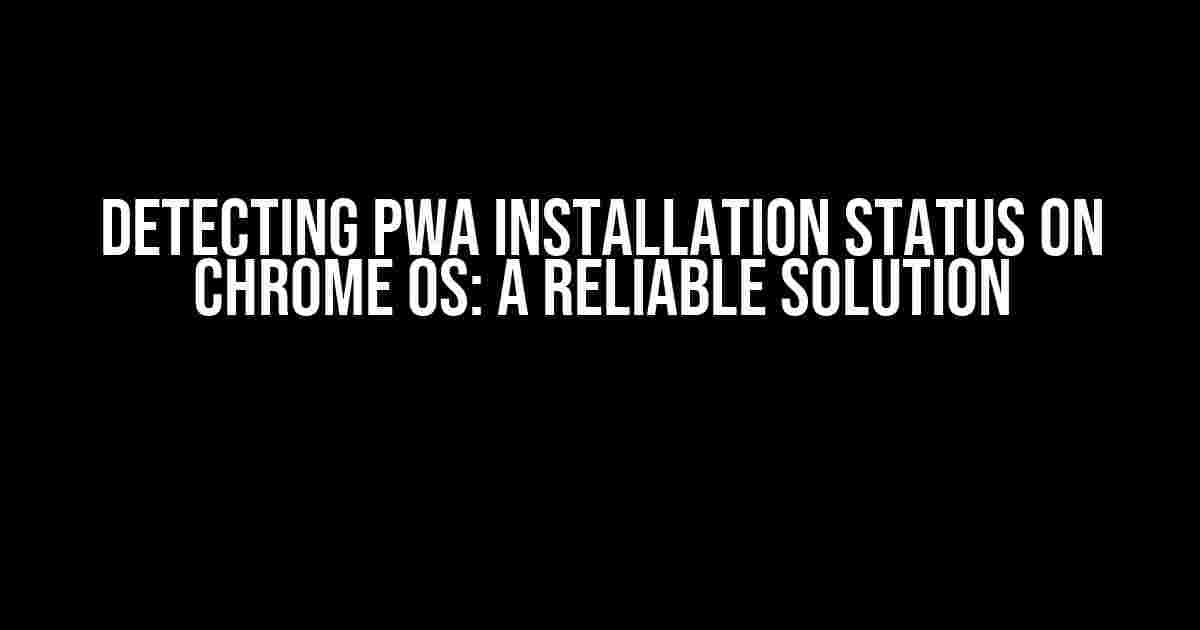The Challenge of Detecting PWA Installation
As a developer, you’ve invested time and effort into creating a Progressive Web App (PWA) that provides a seamless user experience across various platforms, including Chrome OS. However, detecting whether your PWA is installed or not on Chrome OS can be a challenge.
The Solution: Using the `beforeinstallprompt` Event and `matchAll()` Method
To reliably detect if your PWA is installed or not on Chrome OS, you can utilize the `beforeinstallprompt` event and the `matchAll()` method. Here’s a step-by-step guide to implement this solution:
Step 1: Add an Event Listener for `beforeinstallprompt`
Add an event listener to detect the `beforeinstallprompt` event, which is fired when the user is prompted to install your PWA:
window.addEventListener('beforeinstallprompt', (e) => { ... });
Step 2: Use the `matchAll()` Method to Check for Installed PWAs
Inside the event listener, use the `matchAll()` method to retrieve a list of installed PWAs that match your app’s URL:
chrome.management.getAll_self(), (extensions) => { ... }
Step 3: Verify Your PWA’s Installation Status
Loop through the returned list of installed PWAs and check if your app’s URL matches any of the installed PWA’s URLs:
extensions.some((extension) => extension.management.permissions.includes('active'));
Putting it All Together
Here’s the complete code snippet to reliably detect if your PWA is installed or not on Chrome OS:
window.addEventListener('beforeinstallprompt', (e) => {
chrome.management.getAll_self(), (extensions) => {
const isInstalled = extensions.some((extension) => extension.management.permissions.includes('active'));
console.log(isInstalled ? 'PWA is installed' : 'PWA is not installed');
};
});
Conclusion
By implementing this solution, you can accurately detect whether your PWA is installed or not on Chrome OS, providing a seamless user experience and allowing you to tailor your app’s behavior accordingly.
Here are 5 Questions and Answers about “how would I reliably detect if my PWA is installed or not on ChromeOS”:
Frequently Asked Question
Get the lowdown on detecting PWA installations on ChromeOS!
Is there a way to detect PWA installation using the Chrome browser?
Yes, you can use the `beforeinstallprompt` event to detect if your PWA is installed or not on ChromeOS. This event is fired when the browser determines that the user is likely to install your PWA. You can then check if the event is cancelled or not to determine the installation status.
Can I use the `window.matchMedia` API to detect PWA installation?
Yes, you can use the `window.matchMedia` API to detect PWA installation by checking if the installation prompt is displayed or not. You can use a media query like `(display-mode: standalone)` to check if the PWA is installed or not.
Is there a Chrome extension API to detect PWA installation?
Yes, you can use the `chrome.management` API to detect if your PWA is installed or not on ChromeOS. Specifically, you can use the `getSelf` method to get the installation status of your PWA.
Can I use a server-side solution to detect PWA installation?
Yes, you can use a server-side solution to detect PWA installation by checking the `User-Agent` header or the `Chrome-PWA-Installed` header sent by the Chrome browser. However, this approach may not be reliable as it can be manipulated by the user.
Is there a foolproof way to detect PWA installation on ChromeOS?
Unfortunately, there is no foolproof way to detect PWA installation on ChromeOS, as users can manipulate the installation status or use a different browser. However, combining multiple detection methods, such as the `beforeinstallprompt` event and `window.matchMedia` API, can increase the accuracy of detection.
